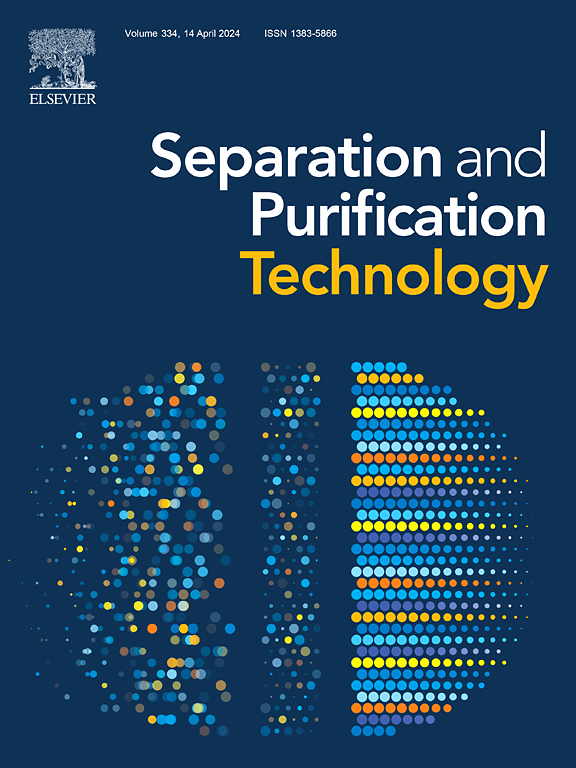Facile construction novel functionalized hyper-crosslinked porous crown-polymers for adsorbing iodine and strontium
IF 8.1
1区 工程技术
Q1 ENGINEERING, CHEMICAL
引用次数: 0
Abstract
The appropriate handling of radioactive strontium and iodine waste presents a significant challenge for the sustainable development of the nuclear industry and the preservation of ecological systems. Developing and fabrication of multi-functional integrated polymers for the capture of iodine and strontium represents a highly promising strategy to address the current challenges. Herein, a series of hyper-crosslinked porous polymers, referred as HCPP-Cn, with tunable hydrophobic properties and pore structures were synthesized via Friedel-Crafts alkylation. The pristine HCPP-C0 demonstrated a good iodine vapor adsorption capacity of 2.81 g·g−1, while the hydrophobic HCPP-C8 achieved an aqueous-phase iodine uptake of 1601.87 mg·g⁻1. To facilitate selective Sr2+ capture, dibenzo-18-crown-6 ether was covalently integrated into the HCPPs framework, resulting in HCPP-Crown-Cn. Among these, HCPP-Crown-C0 exhibited the highest Sr2+ adsorption capacity at 48.17 mg·g−1. Mechanistic studies revealed that iodine adsorption is governed by charge-transfer interactions and π-π stacking, whereas Sr2+ sequestration is driven by size-selective coordination with crown ether. This research offers a strategic methodology to designing functional materials for efficient removal of radioactive iodine and strontium.

结构简单,新型功能化超交联多孔冠状聚合物吸附碘和锶
放射性锶和碘废物的适当处理对核工业的可持续发展和生态系统的保护提出了重大挑战。开发和制造用于捕获碘和锶的多功能集成聚合物是解决当前挑战的一个非常有前途的策略。本文通过Friedel-Crafts烷基化合成了一系列具有可调疏水性和孔结构的超交联多孔聚合物HCPP-Cn。原始的HCPP-C0表现出良好的碘蒸汽吸附能力,为2.81 g·g−1,而疏水的HCPP-C8的水相碘吸收率为1601.87 mg·g−1。为了促进选择性Sr2+捕获,二苯并-18-冠-6醚被共价整合到HCPPs框架中,得到hcpp -冠- cn。其中,HCPP-Crown-C0对Sr2+的吸附量最高,为48.17 mg·g−1。机理研究表明,碘的吸附是由电荷转移相互作用和π-π堆积控制的,而Sr2+的吸附是由与冠醚的尺寸选择配位驱动的。本研究为设计有效去除放射性碘和锶的功能材料提供了一种战略方法。
本文章由计算机程序翻译,如有差异,请以英文原文为准。
求助全文
约1分钟内获得全文
求助全文
来源期刊

Separation and Purification Technology
工程技术-工程:化工
CiteScore
14.00
自引率
12.80%
发文量
2347
审稿时长
43 days
期刊介绍:
Separation and Purification Technology is a premier journal committed to sharing innovative methods for separation and purification in chemical and environmental engineering, encompassing both homogeneous solutions and heterogeneous mixtures. Our scope includes the separation and/or purification of liquids, vapors, and gases, as well as carbon capture and separation techniques. However, it's important to note that methods solely intended for analytical purposes are not within the scope of the journal. Additionally, disciplines such as soil science, polymer science, and metallurgy fall outside the purview of Separation and Purification Technology. Join us in advancing the field of separation and purification methods for sustainable solutions in chemical and environmental engineering.
 求助内容:
求助内容: 应助结果提醒方式:
应助结果提醒方式:


